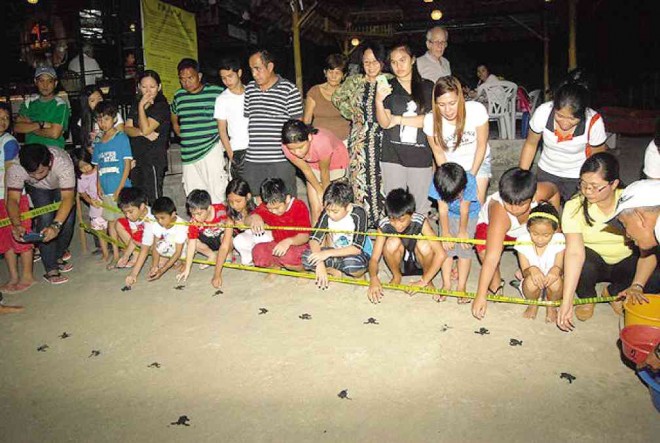59 baby sea turtles released in Subic Bay

Some 50 tourists and their children gathered on the shore of All Hands Beach in Subic Bay Freeport to let loose 59 baby olive ridley sea turtles to their natural habitat. Allan Macatuno/Inquirer Central Luzon Desk
SUBIC BAY FREEPORT, Zambales—Tourists took time off from the holiday revelry at a local beach to release 59 olive ridley sea turtle (Lepidochelys olivacea) hatchlings into the Subic Bay on Saturday.
Around 50 tourists, some of them children, gathered on the shore of All Hands Beach here at 8 p.m. to set the sea turtles free.
Marife Castillo, officer of community environment and natural resources office, said several adult olive ridley sea turtles laid eggs on the resort’s beach last month.
Castillo, who witnessed the release, said All Hands Beach is among the seven major beach areas inside the free port that had been identified as nestling sites for marine turtles (pawikan).
The Subic Bay Metropolitan Authority (SBMA) Ecology Center identified the beaches of Waterfront Area, Dungaree, Edgewater, Grande Island, Camayan, and Minanga as the other nesting sites for sea turtles.
Article continues after this advertisementEmerita Sebial, chief of protected areas, wildlife and coastal zone management service in Olongapo City, said three of the seven species of sea turtle in the world could be found in Zambales province.
Article continues after this advertisementAside from the olive ridley, Sebiang said they received reports that green sea turtles (Chelonia mydas) and hawksbill sea turtles (Eretmochelys imbricata) have been seen in the province.
Sebial said they released the baby sea turtles at night because fewer predators roam the sea at that time.
SBMA Chair Roberto Garcia asked residents and visitors of the free port to support the agency’s marine turtle conservation program.
“These are gentle creatures that need our protection, for without our help they would likely face extinction,” Garcia said in an earlier statement.
He said the SBMA recently launched its “Guard My Nest” sea turtle conservation program to make Subic establishments more “pawikan friendly.”
“This is why we discourage pavement constructions on the beach where the turtles lay eggs, and urge establishments to minimize lighting at night because this disorients the pawikan,” Garcia said.
Angel Bagaloyos, officer in charge of the SBMA Ecology Center, said sea turtles lay eggs mostly during the cold months, from September to February. Allan Macatuno, Inquirer Central Luzon
RELATED STORIES
Grander feast for ‘pawikan’ set in Bataan
Revenge of the ‘pawikan’: 5 dead after eating sea turtle meat